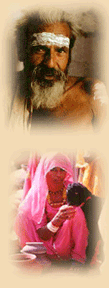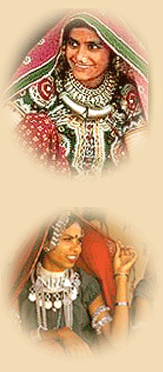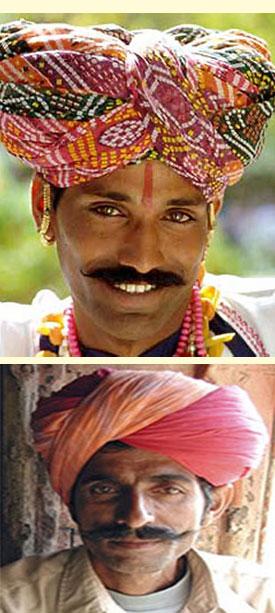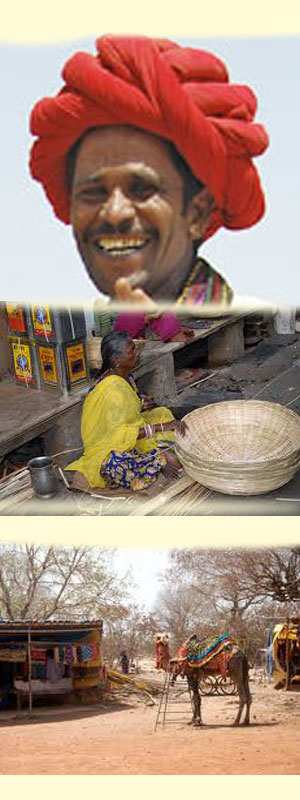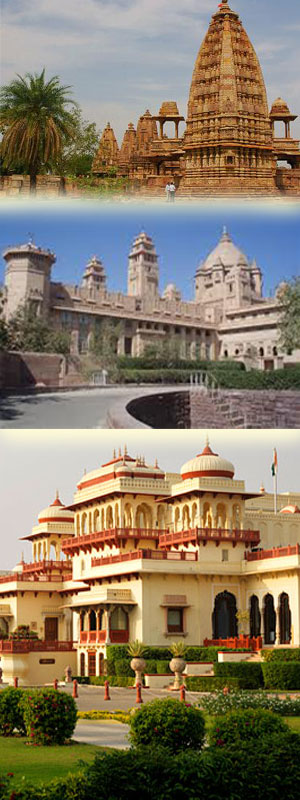|
The theories about the origin of
Rajputs can be classified into certain categories. The most ancient theory is
that they are the progeny of sun, moon and fire. The reference to solar and
lunar dynasties is not traceable in the earliest Indian literature i.e. the
Vedas (1500 to 1000 B.C.) and the Jatakas (3rd century B.C.) but can be traced
back to Mahahharata (5th century B.C. to 2nd century B.C.) and the Puranas
(9th century A.D.). the theory B.C. to 2nd century A.D.), Mahahharat,
Bhagvatapurana (9th century A.d.), the Tamil Poem Purnanuru (6th century
A.D.), the Sanskrit composition Navasahasanka of Padmagupta (11th century
A.D.) and Rajasthani composition Prithviraja-raso of Chandravardayi (12th
century A.D.). This shows that these theories are a concoction of 2nd century
B.C. to claim superiority over the foreigners like Greeks, Parthians and
Scythians or may be that theory of divine origin is a gift from the
Achaemenians who claimed the right to rule by the grace of Ahur-Mazda or from
Alexander the great who was hailed as son of Amon by the priest of the shrine
of the. God Amon Ra (a sun god) in the Sahara desert.
The second theory is that the Rajputs belonged to a foreign stock. This theory
was propounded by James Tod who was the greatest admirer of their virtues but
could not believe that this heroic race of Rajputs could belong to India. He
was followed by A.M.T. Jackson, J. Campbell, Baden Powell, Wiliam Crooke, D.R.
Bhandarkar, P.C. Bagchi and following him, R.S. Sharma. Two Europeans have
remained very discreet. J. Kennedy thought that Chauhans, Solankis and Gahlots
had Indo-Scythic or Gujar origin, the Rajputs of Punjab were of Brahmana stock
whereas Rajputs of Uttar Pradesh originated from Brahmanas, Bihars
(aborigines) and Ahirs (foreign tribe of Abhiras) but thinks that majority of
them were Aryanised Sudras. Vicent Smith Agreed with Crooke that fire-pit
origin mentioned by Chandravardayi was a cover for purifying the foreigners as
Rajputs but about the clans beyond Rajputana and Gujarat he is of the opinion
that they sprang from aboriginal tribes like Gonds, Bhars, Kols etc.
C.V. Vaidya thought them to be Vedic Kshatriyas because they fought for Vedic
religion, believed in solar and lunar origin and the anthropometric
measurements taken in 1901 substantiate their Aryan descent. G.H. Ojha
accepted this theory and believed in the merger of Scythians, Kushanas, and
Huns (among them the Huns were latest stock of the Aryans to arrive.).
Dasharatha Sharma believed that the warrior clans whether indigenous or
foreign passed as Kshatriyas and they were the Rajputs of early medieval
period.
A.C. Banerjee thinks that by the time Rajputs came into field the ancient
tradition of classification according to profession had broken down and that
is why explanation had been given by courtier Brahmanas for their origin.
The present author (J.N. Asopa) has dealt with this issue in detail. He has
traced the clan names of the Rajputs so also of others and has established
that these nomenclatures are simply geographical and have nothing to do with
mythical origins. For example he has connected Panwars with Pragvata or
Pourorai of Ptolemy (2nd century A.D.), extending on both sides of the
Aravalis near Abu; Chalukyas or Salukyas or Chalikis (6th century A.D.) with
river Saiki coming out from Khondmals hills in Orissa; Gurjara (referred to in
Pancfiatantra of 5th century A.D.) pratiharas Juzrs (referred to by Arabs in
7th century A.D.) with river Jozri flowing below Merta and Jodhpur in western
Rajasthan; Chahamans (8th century A.D.) or Sambharia Chauhans with Sambhar
lake in the center of Rajasthan; Guhilas (8th century A.D.) with the guhila
(forest territory lying between river Guhia flowing below Sojat Road and river
Mahi flowing near Galiakot; Gauds with ancient Gauda desa in Haryana Dahias or
Dahimas with Dhadhimati – kshetra (referred to in an inscription of 289
probably of Gupta era=609 A.D.) in Nagour district of Rajashtan; Bhatis with
Bhatiya desa (1000 A.D.) or Bhatinda in Punjab; Chapotkatas (8th century A.D.)
or Chavadas with Bhinmal in south western Rajasthan; Chandellas with Chanderi
in Madhya Pradeshy Kachhavas with eastern rann (Kachchha) of Chambal in Madhya
Pradesh; Rathors with Lat between Narbada and Tapti in southern Gujarat and ;
Kalachuris with Kalvun near Nasik in Maharashtra. He has traced the three big
stocks of Aryans viz. Ikshvakus from laxartes (of the Greeks) now called
Jexates in Central Asia, and Ailas from river Hi flowing much north of
Jexartes in Central Asia, and Agnivanshis to the Agnikona or south – eastern
corner of the Aryan land but lying in the north-west direction of India. On
each one of them the author has made independent studies and then come out
with a conclusion that Rajput is a corrupt from of the Vedic word rajaputra
which has been used as a synonym of rajanya in Rigveda, Yajurvedic Kathaka
Samhita, and Aitareya Brahmana of the Rigveda. In Purusha – sukta of Rigveda
Rajanya is used for the generic class of warriors. It has been used in the
same sense in Atharvaveda but Manu has used the word rajan in place of rajanya.
The term rajan means endowed with kingdom whereas Rajanya means belongings to
rajan. The word Kshatriya meant scion of one endowed with kingdom. But
difference was made in Kshatriyas and rajanyas in Kaushitaki Upanishad (8th
B.C.). It is said there that Soma (king) is eating the Kshatiyas and Vaishyas
respectively with
his two mouths, Brahmana and rajanya was used for the nobles and their scions
whereas Kshatriya was in vogue for the warrior class in general. In the light
of this Upanishadic reference the meaning of the three terms used separately
at a time in Satapatha Brahamana becomes meaningful. There Rajputra, Rajnaya
and Kshatraputra, these three terms are mentioned separately. The rajaputras
(sons of the kings) were entitled to only quivers, and Kshatriyas were holding
simply clubs. Thus as early as 1000 B.C. a difference was made between
rajaputras, nganyas and Kshatriyas.
In Mahabharata (2nd century B.C.) the word rajaputra has been used for the
nobles and warriors (Kshatriyas) at different places; the work Kshatra has
been explained at two places in two places in two different ways by Sayana –
in the commentary of Taittiriya Brahmana he has explained it as domain. By the
time of Sayana the second meaning had become obsolete and the persons holding
the land thought it to be a generic term for warriors and wore the new title
of rajaputra to show their connection with the ruling class. This word has
been continuously in use; Kautilya (4th century B.C.) in his Arthashastra has
used it for sons of the king. Asvaghosha in Saundaranada. St Century A.D.) Has
used it in the sense of nobles and so has done Kalidasa in his
Malavikangnimitra (in 4th century A.D.) – Banabhatta (7th century A.D.) has
used it for nobles in Harshacharita and for the scions of the nobles in
Kadambari. It is in this sense that the word rajaputra or its corrupt form
Rajput became current in early medieval period, i.e. 650 to 1200 A.D.
These men of the ruling class came from different walks of life and different
corners of India. For example Yuan – chwang (7th century A.D.) called Harsha
Fishe (Vaishya). In Aryamanjushrimulakalpa (8th century. A.D.) He has been
said to belong to Vaishya family. Yuan – chwang has not mentioned the word
rajaputra because he was describing only the rajas and not their sons. He has
mentioned their generic social milieu as he knew, for example Pulakesi of
Deccan and Dhruvabhata of Gujarat have been called Kshatriyas. In
Rajatarangini the word rajaputra has been used in the sense of land-owners but
in the same chapter they have claimed their birth from the 36 clans of the
Rajputs. It would lead one to the conclusion that by the end of the twelfth
century A.D. the notion of thirty-six clans of the Rajputs had become well
known and these lists varied according to the information of the author, his
locale and time.
There is one more title rauta, which is still later corrupt form of rajaputra.
This was a title of the landlords and nobles but all of them were not
rajaputras or Rajputs. In Chandella inscriptions we have Brahmanas and
Kayasthas adored with this title. In Rajasthan of modern times we have Rivals
among Khandelwal Vaishyas and also a community known as Ravats whose
profession is to make plate of leaves (pattal) for dining purpose. It is only
the Rajputs or scions of nobles who later became a caste and not all the
landowners who got a title Rawat by grace.
As all the landowners were not Rajputs, in the same way all the Kshatriyas
were not Rajputs. All the rulers in ancient India were not Kshatriyas nor all
the Kshatriyas were actually ruling. Visvarupa, the commentator of Yajnavalkya
says it clearly that the title of dominion (rajya) does not belong to every
Kshatriya. All the rulers were called rajans and their relatives were called
mjaputras. Thus in actual application rajaputra and Kshatriyas did not always
coincide. The ruling classes intermarried with rulers of foreign origin also.
In ancient times Chandragupta Maurya had married the daughter of Seleucos
Nikator. Saka Rudradaman married his daughter to a Satavahana prince and
himself had won the hands of number of princesses in Svayamvaras. In the
post-classical period Harichandra Pratihar of Mandor, who was a Brahmana,
married a Kshatriya Bhadra whose sons passed as Rajputs. All this does not
substantiate the theory of foreign origin.
The theory of the foreign origin of the Rajputs can be substantiated only on
one basis i.e. that the Aryans in the hoary past came to India from Central
Asia and as most of the Rajputs contain Aryan blood they are foreigners. The
mixture of the aborigines cannot be denied on the basis of anthropology but no
dynasty can be historically proved to have had developed from an aboriginal
tribe into a Rajputs clan. The question arises: what was the historical milieu
of all the Rajput clans? The source material for the same is not available.
However, the present author has traced the origin of 15 clans about whom some
source material is available. Though geographical basis of clan is common to
all, in some cases even social milieu could be traced. He has traced the
Paramaras, Chalukyas, Pratiharas and Chahamanas to Agney-Brahmanas; Guhilas
and Chandellas are also traced to Brahmanical origin; Mauryas and Kalachur are
traced to ancient Kshatriyas whereas the ancient social milieu of the Gaudas,
Dahimas, Bhatis, Chavaras, Gahadvasa, Rathors and Kachhawa is said to be
untraceable before their passing as Rajputs though their original home which
is the cause of their name has been traced.
The author in his support has brought to bear the evidence iiot only of
ancient Indian writers but the contemporary authority of Arab scholar Ibn
Khurdadha who was the author of Kitabul-Masalikwa-Mamulik (912 A.D.). He has
differentiated between the ruling classes, Sabkurifa and Kshatriyas old known
as Katarias. He said that Subkurifa (Arabic rendering of Sudshatriya) was the
highest clan from which the rulers were selected. For Kataria he says that the
people of this clan drank only three cups of wine. Their daughters could be
married to these Katarias. It is quite clear that the ruling class as composed
in the postclassical period distinguished themselves from the Kshatriyas who
had lost their kingdoms long back. Though these two words were not coined by
the Muslims as shone above yet Qanungo says that there is no epigraphically or
literary evidence down to 1000 A.D. to indicate definitely the use of the word
Rajput to denote a class or caste. He, however, says tat this word might have
been in official use. A.K. Majumdar agreed with the view that Rajput has been
derived from the term rajaputraka but was wavering in his using the word
rajaputraka in the sense of Rajputs; Mt. Abut inscription (1230 A.D.),
speaking of rajaputras of illustrious Rajputra clan; and Merutunga (1305 A.D.)
describing 100 rajputras of Paramara clan. To this list can be added
Rajatarangini of Kalhana (1200 A.D.) and Chittor inscription of 1301 A.D. The
Chittor inscription is a clear evidence of the fact that by the close of the
fact that by the close of the 12th century the Rajput class has converted into
a caste. In this inscription the donor, his father and grand-father all have
been classed as rajaputra and the ruling noble has been called Maharajakula in
addition to being called a Rajaputra suggesting thereby that the first was the
title and the second was a caste appellation. Kalhanaas Rajatarangini also
describes the Rajaputras claiming origin from 36 royal clans.
We can thus conclude that Rajaputras were a class upto the classical period,
and from Harsha’s time up to the time of Prithviraja Chauhan, besides two
Kshatriyas clans of Mauryas and Kalachuris, many non-Kshatriya groups – six
groups of Brahmanas, one foreign tribe of Hunas and five non-descript people
whose ancient social milieu is not known with certainty entered in to Rajput
group and later became clans of this caste. This survey would lad one to the
conclusion that Rajputs were a class up to the Rajput period in c. 1200 A.D.
and became a caste only after the Turks entered the political field and
refused to be Aryanised. For the first time a stumbling block came in the way
of the Rajputization of the rules and the practice fell into abeyance and even
the local Hindu rulers after that had to be content with power but could not
be included among the Rajputs as the Chaturvarnya system received a great set
back at the hands of the unbelieving Turks who had brought new society and
religion with them. |


